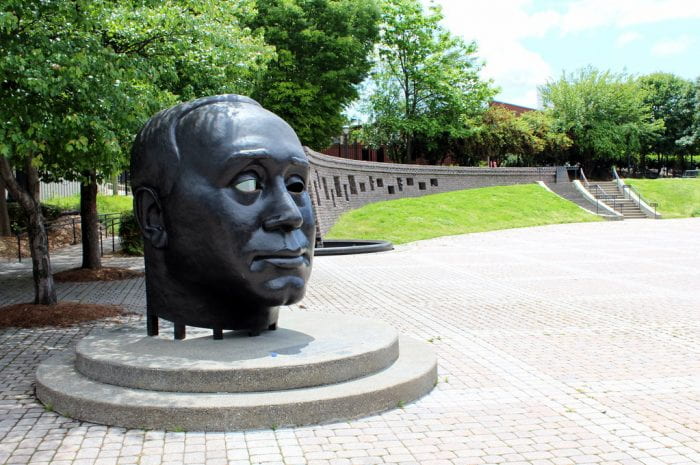In my many years at Georgia State I have been at war with parking. I somehow always managed to be too late to sign up for any sort of prime parking spot on campus, yet always refused to ever pay for any sort of conventional campus parking on the terms that I was already paying for my spot in class. My hardheadedness paid off in a way because I usually parked in the free street spots around Edgewood Ave. I always enjoyed walking around the Sweet Auburn area because it was decorated with murals and older buildings. It is truly one of the few areas in Atlanta where you can feel the history. My favorite sculptures in this area is one of a giant man’s head on the corner of Auburn and Fort Street. For the longest time I was not sure of who the sculpture was in honor of. One day when walking to class with a friend I asked her if she knew and she replied “um, I think Martin Luther King? That would make sense.” So for an embarrassingly long time I thought the sculpture was just a bad interpretation of the Reverend Martin Lither King. After all, when you’re in a hurry to make it to class, who has the time to check the very easily accessible plaque telling the history of the square.
I later found out that the square the sculpture is housed in is called John Wesley Dobbs Plaza, and the sculpture is (unsurprisingly) a depiction of John Wesley Dobbs. Dobbs was born in Marietta and moved to Savannah when he was two years old. He studied at Atlanta Baptist College which later became Morehouse College. He worked as a railway mail clerk for the Post Office for 32 years and built a reputation of helping and growing his community in Atlanta. He was considered the “unofficial” mayor of the Sweet Auburn area throughout his life. He helped in voter registration drives so that the black community in Atlanta would have their voice heard. His efforts in churches, businesses, and street corners made it so over 10,000 black voters were registered in the 1930s. Dobbs himself was the reason “Sweet Auburn” was coined for the thriving Auburn Avenue area.
In the sculpture, Dobbs’ eyes are cut out so that the viewer can stand within his head and see the Auburn Avenue he helped build today. I am very embarrassed for not knowing immediately who the sculpture depicted. Although I grew up very close to Atlanta and attended university in the city, my knowledge of Atlanta Civil Rights leaders is very minimal . Despite the narrative of Atlanta being a”black Mecca” the history of the city is still very much white washed. In the interview on the podcast About South, Calinda Lee with the Atlanta History Center says:
“Whats not is narssistic and static is empathy […] guilt is very much this navel gazing and strife around being disabused […] but empathy can be uncomfortable if you have not practiced it”
I feel this is an important thing to remember when processing and understanding ideas of white guilt. It is so easy to feel upset or betrayed by those who taught Georgia’s history so narrowly to us and to feel almost robbed of a true history. It makes one question their own standing in the world, and dwell on the guilt instead of building a better future.
Photo source: https://www.flickr.com/photos/wallyg/9056118847
